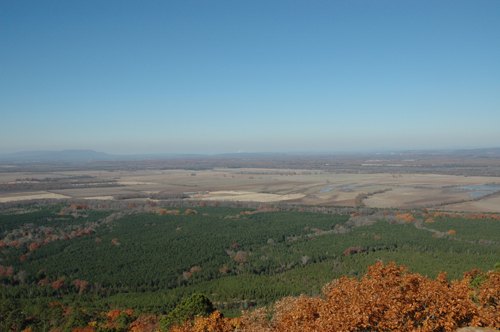Introduction to the CARV Project
In June 2009 the Arkansas Archeological Survey was awarded a $240,000 grant from the Collaborative Research Program of the National Endowment for the Humanities to support a three-year study of American Indian art, ritual, and social interaction in the central Arkansas River Valley. The project involves a unique collaboration between members of the Arkansas Archeological Survey, graduate students in the Department of Anthropology, and members of the Caddo, Osage, and Quapaw Indian nations of Oklahoma. The project has been designated a National Endowment for the Humanities “We the People” project. The goal of this special NEH initiative is to encourage and strengthen the teaching, study, and understanding of American history and culture through support of projects that explore significant events and themes in our nation’s history and culture and that advance knowledge of the principles that define America. Dr. George Sabo III is project co-director, along with Dr. Jami J. Lockhart of the Survey and Dr. Andrea Hunter of the Osage Nation of Oklahoma. Robert Cast, Bobby Gonzalez and LaRisha Wabaunassee of the Caddo Nation will be participating along with Jean Ann Lambert, Ardina Moore, and Carrie Wilson of the Quapaw Nation. Project participants also include University of Arkansas Anthropology graduate students Duncan McKinnon, Leslie Walker, and Rebecca Wiewel, and Arkansas Archeological Survey archeologists Dr. Ann Early, Michael Evans, Jerry Hilliard, David Jeane, Aden Jenkins, Tim Mulvihill, Jared Pebworth, Larry Porter, Deborah Sabo, John Samuelsen, Dr. Leslie C. Stewart-Abernathy, and Deborah Weddle.
The Carden Bottoms locality of the central Arkansas River Valley is famous as the source of extraordinary artifact collections, including hundreds of exquisitely decorated ceramic vessels, preserved in museums across the country. Many of the decorations on these ceramics incorporate elements of artistic styles originating at the World Heritage Cahokia site near modern St. Louis, and later represented in ceremonial contexts at the Spiro Mounds site located farther up the Arkansas River. In a recent (2003–2006) project on ancient Arkansas rock art funded by a previous NEH Collaborative Research Program grant, a team of Arkansas Archeological Survey archeologists led by Sabo discovered that exposed rock surfaces near the Carden Bottoms locality are decorated with pictographs and petroglyphs reflecting the same artistic style. The ceramics and rock art are attributed to a late prehistoric to protohistoric era (A.D. 1400–1700) American Indian community archeologists refer to as the Carden Bottoms phase. The relationship between the Carden Bottoms phase people and the historic Caddo, Osage, Quapaw, and Tunica Indians has been a topic of considerable debate for nearly a century, but remains unresolved. Up to now, archeologists have learned very little about the people who produced these extraordinary materials, mainly because study has been limited to the existing vessel collections, most of which were looted from cemeteries during the early 20th century. Prospects for controlled investigations at other types of sites, including residential and ceremonial sites, are threatened by the impacts of continued looting—fueled by today’s market among private collectors for buying and selling American Indian antiquities—and modern land use practices. This worrisome situation alarms archeologists and modern American Indians alike. In response to this circumstance, this project will employ modern remote sensing technologies to locate preserved habitation features at several Carden Bottoms phase sites. The Caddo, Osage, and Quapaw descendants of the pre-contact people who lived in Arkansas will join Arkansas Archeological Survey archeologists in the excavation of those features to generate new information concerning the daily lives of the Carden Bottoms phase people. This new information will provide a better context for studying the existing museum collections, which in many cases have remained as objects hidden away on shelves for decades, providing little information to scholars, descendant communities, or the interested public. By combining analysis of results from the new excavations, reanalysis of existing museum collections, and ongoing studies of regional rock art, project participants will examine the role of art and ritual in the expression of cultural identity and in the organization of regional social interaction. The team hopes to bring some advancement to the thorny problem of tracing cultural boundaries through time. |
||
 |

|
